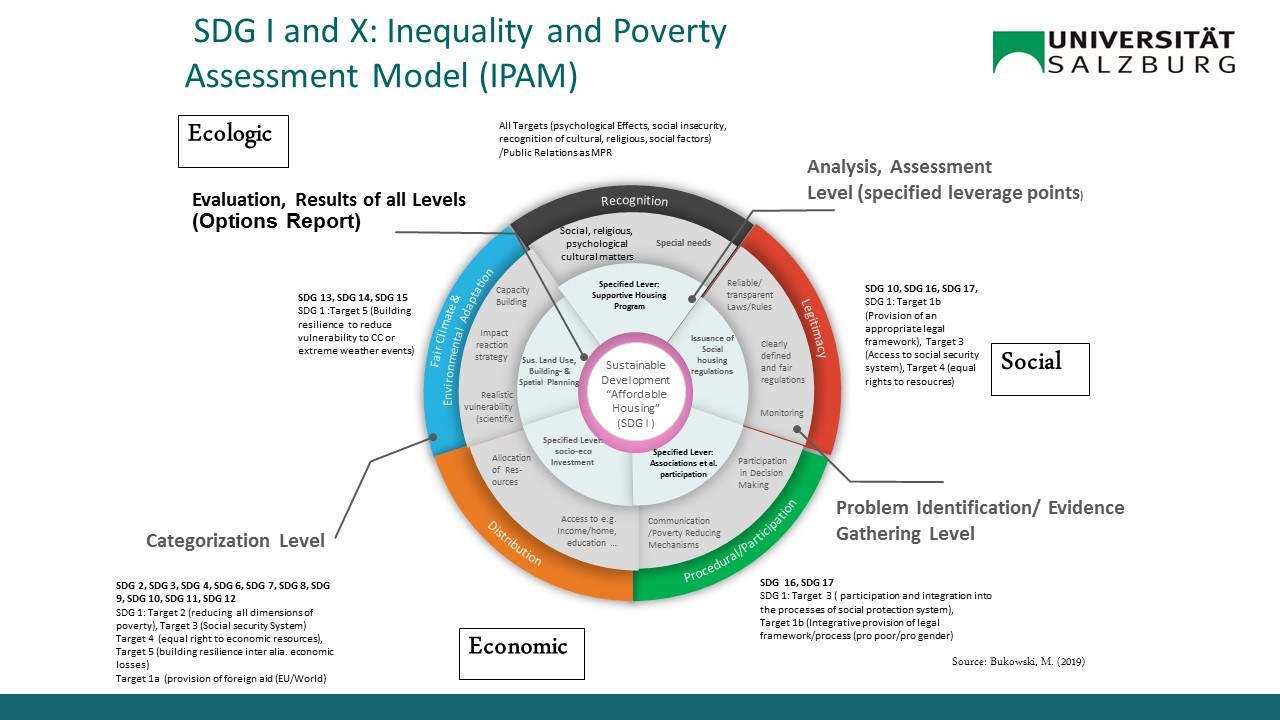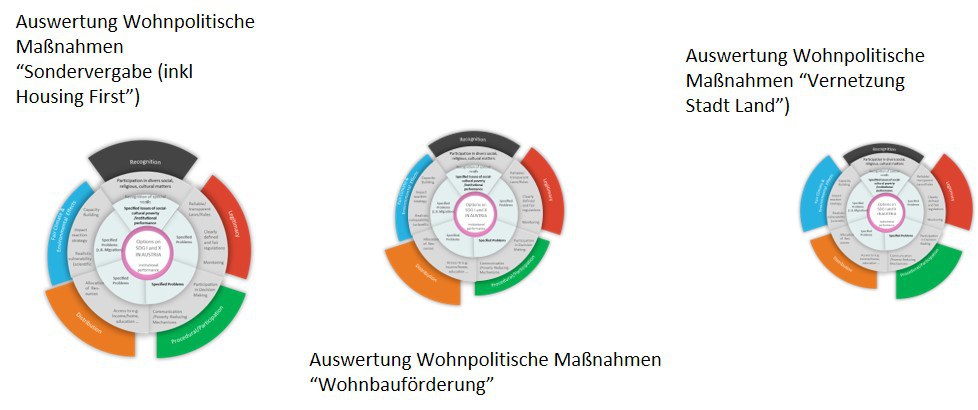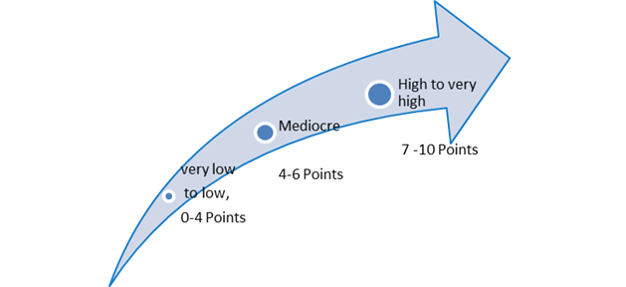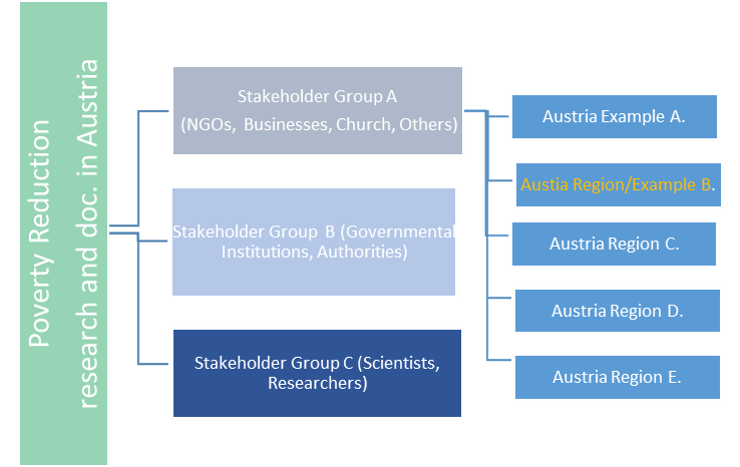/Contribution
SDG 1: Strategic Approach, Concepts and Perspectives / Strategisches Vorgehen, Konzepte und Perspektiven
In Folgenden geben wir einen kurzen Einblick in unsere Arbeit zum SDG 1, unsere strategischen und konzeptuellen Überlegungen sowie methodischen Ansätze. Der Text ist bitte als vorläufiges Erzeugnis zu verstehen. Aufgrund der erweiterten Zugänglichkeit und des Austausches, wurde dieser Artikel auf Englisch verfasst mit einer längeren deutschen Zusammenfassung.
This paper is meant to give a brief overview of our work on SDG 1, our strategic, conceptual and methodological considerations. Please understand this text as work in progress, i.e. all areas are subject to change. To include a wide range of scientists and experts on the international topic of SDG1 (Poverty Reduction) we decided to write this newsfeed in English with a longer German summary.
Deutsche Zusammenfassung:
Um einen Optionenbericht mit Blick auf das erste Nachhaltige Entwicklungsziel der Vereinten Nationen (SDG1) für Österreichs Regierung zu gestalten, sehen wir unseren systemischen Ansatz darin, das Thema „Armutsreduktion“ (inklusive Targets und Indikatoren) innerhalb einer nachhaltigen Entwicklung widerzuspiegeln. Dafür orientieren wir uns zunächst am Begriff der „Nachhaltigkeit“, insbesondre am Nachhaltigkeitsdreieck von Kleine (2005). Ausgehend von quantitativen Daten der Armuts- und 1 Ungleichheitsforschung, wie Armutsstatistiken ( 1), Chi² (Ungleichverteilungsraten) et al., werden Analysen und Studien herangezogen, die die zugrunde liegenden Prozesse und Verflechtungen hinsichtlich Armut, Ungleichheit und Teilhabe analysieren. Dies rührt daher, dass der soziale, ökologische oder materielle (ökonomische) Ausschluss gesellschaftlicher Gruppen zumeist eng verflochten ist mit einer gerechteren Verteilung von sozialen und materiellen Ressourcen (Sobhan 2010, Ostrom 2009). Aus diesem Grund, und, um die zu analysierenden SDG 1 Targets im Sinne einer nachhaltigen und gerechten Entwicklung zu untersuchen und dadurch Lösungsansätze (Optionen) zu identifizieren, wurde ein fünf dimensionales „Poverty Assessment Modell“ (PAM) entwickelt (vgl. Bukowski 2018). Das Modell basiert auf etablierten, theoretischen Ansätzen aus der 2 Gerechtigkeitsforschung, inkl. Erkenntnissen aus den Bereichen des nachhaltigen Ressourcenmanagements (Sikor 2013, Agrawal et al. 2009) der Governance (Ostrom 2009) sowie den Sozial-, Klima- und Umweltgerechtigkeits-Ansätzen (Rawls 1971, Roemer 1996, Sen 2009a, 2009b, Schlossberg 2007, Ager et al. 2006, 2014). Das Modell erlaubt, ob seiner Struktur und Offenheit, die verschiedenen Nachhaltigkeitsbereiche und deren Überschneidungen zu erfassen und sie den verschiedenen Targets zuzuweisen sowie Maßnahmenbeispiele für die jeweiligen SDG 1 Targets zu finden. Diese lassen sich durch die offenen Nachhaltigkeits-Dimensionen/Kategorien des Modells leicht in Verbindungen mit anderen SDGs bringen.
1 Armutsrisikoquote, der Überschuldungsquote oder dem Ausmaß materieller Deprivation (quantifizierbare Abbildungen der sozialen und wirtschaftlichen Lage der Menschen in Österreich).
2 Vornehmliche Orientierung an den Begriffskonnotationen aus dem angelsächsischen Raum, daher werden hier eher die Begriffe „Social and Environmental Justice“ verwendet.
3 Weitere Information bitte unten (Sektion A. PAM).
4 Diese umfassen u.a. die Analyse der gefundenen Maßnahmen mit Blick auf die quantitativen Daten und Nachhaltigkeitsbereiche.
SDG 1 Strategic Approach, Concepts and Perspectives
This first SDG 1 (No Poverty) working paper can be viewed as a “guideline and/or strategy” to generate a scientific options-report for the Austrian government on poverty reduction in all its forms by 2030 (UNDP 2019). This strategy paper aims to find ways, concepts and methods for the investigation, evaluation and assessment of poverty-related research, publications, official documents etc. as well as possible ways of communication and inclusion of transdisciplinary stakeholders.
TABELLE FEHLT!
A. Research and Assessment Strategy (SDG 1: Poverty Assessment Model)
Our scientific SDG 1 options-report team aims to find options to target poverty and poverty risks in Austria. Furthermore, we wish to enhance the value of individual research on poverty and uneven development by acknowledging interdisciplinary poverty research and studies (from various fields.) This is necessary as it reflects the broad topics, approaches and methods of poverty research that vary from quantitative statistical data to small-scale qualitative studies. Thus, the challenge is to find an adequate mixture of all fields of relevant poverty research dealing with Austria. Beyond that, there are many different approaches to the definition of poverty alone, for instance, the ever-ongoing debate on appropriate concepts of “absolute poverty” (Gaisbauer et al. 2019, p. 7) and “relative poverty” (Chen et al. 2009). One of the definitions that briefly describes the latest accordance offers the World Bank (2019) and UNO (2017). They define “absolute poverty” as having access to no more than $1.25 a day of purchasing parity power. Whereas “relative poverty” measures the individual against a larger group, answering questions on the disparity between social groups at the very low socioeconomic end and the rest of the cohort. Yet, central to understand the dynamic nature of poverty is also the consideration of the solutions, measures or options to alleviate poverty. Therefore, we find it necessary to consider direct examples and qualitative findings in order to contextualize quantitative statistical data. As the issues of poverty are highly dynamic, it might also be useful to use an adapted version of a scenario analysis to predict possible threats/options of poverty reduction that are not yet scientifically assessed (like the effects some present changes on the social system may have).
SDG 1: Poverty-Assessment-Model Dimensions/Categories:
We identified five broad Dimensions that integrate the most prevalent scientific ideas of categorization of Poverty and its various forms (UNDP 2017) as they are included in the UN SDG 1 Targets/Indicators.
SUSTAINABLE DEVELOPMENT: A. ECONOMIC SCOPE
1. Distributive Poverty: This dimension includes the access to resources, basic needs, material ones, economic ones, social ones (Rawls 1978, Roemer 196, Schlossberg 2007, Sen 2009, Ostrom 2009, etc.)
(Information gathering: A. Quantitative material on distributive poverty. B. Qualitative material on distributive poverty (small scale, close-up, check-up).
SUSTAINABLE DEVELOPMENT: B. SOCIAL SCOPE
2. Participation/Procedural: This dimension with the inclusion of stakeholders in the processes of decision-making and communication; possibilities to take part in society, economy, politics (Tyler 1990, Ostrom 2009, 2011, Sen 2009, Towela-Sambo 2012, Sikor et al. 2013.
(Information gathering: A. Quantitative material on procedural poverty. B. Qualitative material on
procedural poverty (small scale, close-up, check-up).
3. Legitimacy: This factor is defined through legal perspectives (rights, regulations and laws) dealing with poverty, i.e. whether there are reliable, transparent rules and laws to address poverty. Such as, for instance, legal access and structures to the social security system, and other forms of governmental regulations to target poverty (Tyler 1990, Paloniemi et al. 2011, Gezelius 2002, Stern et al. 2008b, Ostrom 2009, Ostrom 1990 et al.).
(Information gathering: A. Quantitative material on legitimate issues of poverty. B. Qualitative
material on legitimate issues of poverty (small scale, close-up, check-up).
4. Recognition/Perception: This dimension focuses on the acknowledgement of people’s district (5) identities (socially, culturally, indigenous etc.) (Sikor 2013, Schlossberg 2007, Martin et al. 2016), and resulting capabilities and notions of poverty. This includes not only access to cultural matters but also the individual “shame”. Recognition/Perception are tangent to all factors of social, economic and environmental poverty and justice. The respect within the governance and management for social and cultural differences (gender, age, origin, etc.) in an antidiscriminative way is the desired outcome concerning poverty reduction efforts.
(Information gathering: A. Quantitative material on distributive poverty. B. Qualitative material on distributive poverty (small scale, close-up, check-up).
SUSTAINABLE DEVLOPMENT: C. ENVIRONMENTAL SCOPE
5. Fair Climate- and Environmental Adaptation: This dimension explains the connection between climate and environmental vulnerability and the poor and marginalized (Adger et al. 2014, Paavola et al. 2006, UNEP 2012).
(Information gathering: A. Quantitative material on distributive poverty. B. Qualitative material on
distributive poverty (small scale, close-up, check-up).

The model works twofold: Either problem focused/option focused: to assess certain poverty-prone areas/fields with regard to problematic poverty-justice implications (both for absolute/relative poverty notions) or to derive options along the poverty justice impacts on residents of Austria. Furthermore, it can be used to measure and evaluate the institutional performance on poverty reduction. The implementation of poverty justice ideas inspired by the SDGs are likely to support insights on problems and measures of poverty reduction and can reveal positive/negative characteristics. We will back up the gathered information and measures with expert group interviews/discussions in order to evaluate options for the report. The poverty and justice centered model offers an advanced form of “Social Impact Assessment” of poverty issues. In the best case, it enables researchers, institutions, practitioners and planers to comparatively evaluate areas and improve institutional performance with regard to particular phenomena that bear possible negative/positive outcomes. The theory-driven criteria have been proven by numerous scholars to be supportive for sustainable and peaceful governance as well as management of socioeconomic and socio-environmental systems. PAM Levels: The first level shows the broad categorization of relevant justice issues within poverty research Problems can be detected and addressed in the second level, which is called “the problem/option identification level”. The third level, the “analysis level”, analyzes the problems/options as well as further findings, and includes feedback through experts.
B. Methods and Stakeholder Analysis Framework
The comparative PAM Analysis of the gathered information can depict different forms of outcome (a. cumulated for Austria, and b. exemplary, topic/site-specific outcomes). Please find below examples of (6) PAM outcomes.

Methods: Statistical analysis (qualitative data analysis (Mayring), computer-based qualitative/ quantitative data analysis (MaxQDA), expert interviews, focus group interviews (semi-structured). Another methodological approach would be an options-scenario analysis to take current actions with unknown results into account. For a further qualification of the outcomes of the different categories, expert/group interviews will be conducted to evaluate outcomes and to double-check the measures and options (incl. a weighting of the relevance of the same) for the analysis.
Methods: Statistical analysis (qualitative data analysis (Mayring), computer-based qualitative/ quantitative data analysis (MaxQDA), expert interviews, focus group interviews (semi-structured). Another methodological approach would be an options-scenario analysis to take current actions with unknown results into account. For a further qualification of the outcomes of the different categories, expert/group interviews will be conducted to evaluate outcomes and to double-check the measures and options (incl. a weighting of the relevance of the same) for the analysis.

Source: Meike Bukowski 2019

Source: Meike Bukowski 2019
C. Partners and Public Relation Strategy
1. Partners/ Affiliates
a. UniNEtZ, AG Dialogue, AG Methods
b. ZEA/ifz, Social Geography
c. PRME/ UN SDG 1 Groups
d. Students/Researchers/ Artists
e. NGOs (Südwind, Greenpeace, SDG Watch), Arbeiterkammer, Caritas, (weitere Kirchen- und Sozialverbände)
2. Action Planning
a. Workshops, Seminars, Action Days, Lectures (Ringvorlesung), Fest
b. Video/Radio/Newspaper/Art/Science Festival/
c. Publications
Conclusion
This work in progress paper tries to describe the general approaches and ideas of our work on the SDG 1 options-report. We seek to derive measures that target poverty in Austria through the scientific literature, which then will be evaluated further by diverse transdisciplinary expert groups. To identify, categorize and analyze the findings of the poverty research and to assess possible options in light of sustainable development we have designed our own SDG 1: Poverty Assessment Model. Further, we work on the inclusion of diverse stakeholders and transdisciplinary partners, action planning and public relations in order to promote the importance of the “poverty reduction” topic that is often understand as alleged insignificant in Austria.
5 Recognition and Perception are concerning all social contacts, the government and society (especially with regard to the measures targeting poverty).
6 The examples are derived from previous studies (Bukowski 2018)
Reference List
Adger, W.N., Paavola, J. (2006): Analysis Fair Adaptation to Climate Change. Elsevier, Ecological Economics Vol. 56, USA, pp. 594 – 609. University Press, New York, USA.
Agrawal, A. (2001): Common Property Institutions and Sustainable Governance of Resources. Elsevier Science Ltd. World Development Vol. 29, No. 10, pp. 1649 – 1672.
Agrawal, A.; Redford K. (2009): Conservation and Displacement: An Overview. Conservation and Society, Vol. 7, pp.1 – 10.
Bukowski, M. (2018): Environmental Conflict and Conservation Justice in Marine Protection: A CJC Analysis. BIS Verlag (University Oldenburg Press), Oldenburg, Germany.
Epstein, J. M. (2006): Generative Social Science - Studies in Agent-Based Computational Modeling, Princeton Studies in Complexity, Band 13. Princeton, USA.
Fisher, R.J.; Maginnis, S.; Jackson, W.J.; Barrow, E.; Jeanrenaud, S. (2005): Poverty and Conservation: Landscapes, People and Power. IUCN, Gland Swizz, and Cambridge, UK.
Gaisbauer, H.; Schweiger, G.; Sedmak, C. (2016): Ethical Issues in Poverty Alleviation. Springer International Publishing. Switzerland.
Gaisbauer, H.; Schweiger, G.; Sedmak, C. (2019): Absolute Poverty in Europe. Interdisciplinary Perspectives on a Hidden Phenomenon. The Policy Press, University of Bristol, UK.
Kapferer, E. (2018) Die Armut der Anderen? Armut, Öffentlichkeit und Menschenbilder. Cennamo I. Peterlini H. (hg.) Menschenbilder in der Weiterbildung. Kritik-Diskussion und Reflexion. Meran: Edizioni alphabeta Verlag. Meran, Italien.
Koch, A. (2018): Quod Erat Expectandum. The Modus Operandi of Models and Quantifications. In: GI_Forum 2018, Issue 1 (No 6), Salzburg, Austria DOI: 10.1553/giscience2018_01_s274.
Latour, B. (2005): Reassembling the social: an introduction to actor-network-theory. Oxford University Press. Oxford, New York.
Martinez-Alier, J. (2002): The Environmentalism of the Poor: A Study of Ecological Conflicts and Valuation: Edward Elgar Publishing, Massachusetts, USA.
Martinez-Alier, J. (2012): The Environmentalism of the Poor: Its Origins and Spread. In A Companion to Global Environmental History. J. R. McNeill and E. S. Mauldin (eds.), John Wiley & Sons, Ltd, Colchester, UK.
Mayring, P. (1996): Einführung in die qualitative Sozialforschung. Eine Anleitung zu qualitativem Denken (3rd Edition). Psychologie Verlags Union, Weinheim, Germany.
Mayring, P. (2000a): Qualitative Inhaltsanalyse. Grundlagen und Techniken. 7th Edition (1st. Edition 1983). Deutscher Studien Verlag, Weinheim, Germany.
Mayring, P. (2000b): Qualitative Content Analysis. Forum Qualitative Sozialforschung/ Forum: Qualitative Social Research, Vol. 1, Issue 2, Art. 20.
OECD/FAO (2016): Adopting a Territorial Approach for Food Security and Nutrition Policy, OECD Publishing, Paris, France.
OECD (2017): Policy Coherence for Sustainable Development 2017: Eradicating Poverty and Promoting Prosperity. OECD Publishing, Paris, France.
Ostrom, E. (2009): Design Principles of Robust Property Rights Institutions: What Have We Learned? In Property Rights and Land Policies, Lincoln Institute of Land Policy, Cambridge, USA, pp. 25 – 45.
Ostrom, E. (2011): The evolution of institutions for collective choice action. 19th Edition. Cambridge U
Paavola, J. (2005): Environmental Conflicts and Institutions as Conceptual Cornerstones of Environmental Governance Research, Technical Report in Working Paper. Centre for Social and Economic Research on the Global Environment (CSERGE) Working Paper, EDM 05-01, UK.
Paavola, J.; Adger, N. (2006): New institutional economics and the environment: Conceptual foundations and policy implications. CSERGE Working paper, EDM 02, UK.
Paavola, J. (2007): Institutions and environmental governance: a reconceptualization. Ecological Economics, Vol. 63, Issue 1, pp. 93 – 103.
Rawls, J (1971): A theory of Justice, Cambridge, Mass., Belknap Press of Harvard University Press, USA.
Roemer, E.J. (1996): Theories of Distributive Justice. Harvard University Press, USA.
Schlossberg, D. (2007): Defining Environmental Justice: Theories, Movements, and Nature Oxford University Press New York, USA.
Schroth, J. (2008): Distributive Justice and Welfarism in Utilitarianism, Inquiry, Vol. 51, pp. 123 – 146.
Sen, A.; Dreze, J. (1989): Hunger in the Modern World, Clarendon Press, Oxford University Press on Demand, New York, USA.
Sen, A. (1993): Capability and Well-Being. In Nussbaum, M.; Sen, A. (eds.). The Quality of Life. Clarendon Press, Oxford, UK, pp. 30 – 53.
Sen, S.; Nielsen, R.J (1996): Fisheries co-management: a comparative analysis. Marine Policy, Vol. 20, pp. 405 – 418.
Sen, A. (2009a): The Idea of Justice. Cambridge, Belknap Press/Harvard University Press, Cambridge, USA.
Sen, A. (2009b): A theory of justice, Harvard University Press, Cambridge, USA.
Sikor, J. (2013): Justices and Injustices of Ecosystem Services, Earthscan, Routledge, New York, USA.
Sobhan, R. (2010): Challenging the injustice of Poverty. Agendas for inclusive development in South Asia. Sage Publications, LA, USA.
UN (2010): Millennium Development Goals (MDG) Report – Addendum. United Nations, New York, Mdgs.un.org. (Accessed April 6th 2012).
UN (2012): The Future we want. Outcome Document of the United Nations Conference on Sustainable Development (Rio+20). United Nations, Rio de Janeiro, Brazil. (Retrieved on November 2013).
UN (2016): Global Sustainable Development Report 2016, United Nation, Department of Economic and Social Affairs, New York (July) (Retrieved September 2016).
UN General Assembly (2005): 66th Session “Follow-up to paragraph 143 on human security of the 2005 World Summit Outcome” (A/RES/66/290). (Accessed on October 25th 2012).
